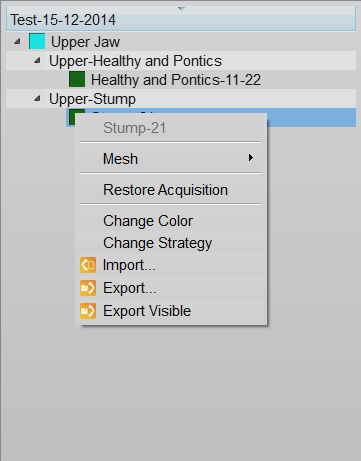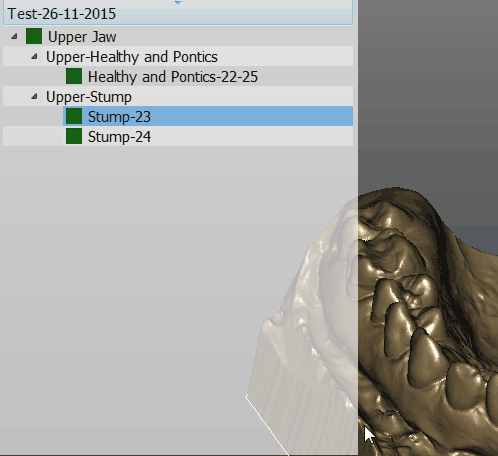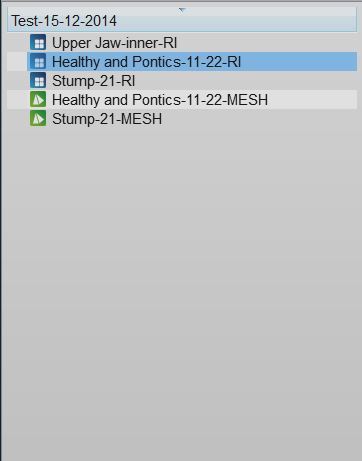Project Tree
Contents
Árbol de Proyecto
La ventana situada en la esquina inferior izquierda de la Interfaz del software es el panel de gestion del proyecto, contiene todos los datos adquiridos y modificados.
El arbol proyecto de un proyecto estruturado es diferente de lo de un proyecto libre.
Proyecto Estruturado
Esta imagen muestra un ejemplo de un Arbol Proyecto Estruturado:
La imagen siguiente muestra un ejemplo de Arbol Proyecto en un proyecto estruturado
Estado de datos y Seleccion
Hay 3 estados diferentes que definen cada objeto del proyecto, cada estado está marcado por cajas de color diferente:
- Ningun Datos (Icono Gris): este elemento es necesario para que el proyecto sea completo, pero no hay datos disponibles. Es necesario importarlo o escanearlo.
- Adquirido (Icono Azul): hay una adquisicion de este elemento. Es posible alinearlo con el proyecto, editarlo o convertirlo en un formato malla.
- Malla (Icono Verde): en este proyecto hay una malla que puede ser exportada o modificada.
Es posible interactuar con el Árbol de Proyecto:
- Haga clic con el boton izquierdo en un elemento para seleccionarlo
- Haga clic con el boton izquierdo, manteniendo pulsado CTRL, en un elemento para añadirlo a la selección actual.
- Haga clic con el boton derecho en un elemento para abri el "Menu contextual del elemento"
- Haga clic con el boton izquierdo fuera de la lisa para limpiar la seleccion actual
Todos los elementos seleccionados podran ser visualizados en la Vista 3D y los botones para todas las acciones disponibles de los menus, el Barra de herramientas principal y el Barras de herramientas secundarias segun la seleccion actual.
The information is layed out as a tree; each element can have children elements. This scheme represents the information dependency in the project. For example a single stump is part of a jaw so it's a child of the jaw and the software, when asked to align the stump to the rest of the project, will align it to its parent jaw.
Context Menu
By right clicking on a Project Tree element, a context menu will appear:
The context menu shows:
- A Sub Menu with the tools for the selected element (Mesh, Acquisition)
- A Restore Acquisition button that will remove a mesh and recover the previous acquisition
- A Change Color button that will change the assigned color of this element, used in the 3D View
- A Change Strategy button that will change the scan and mesh strategy of this element
- An Import... button that will import an acquisition or mesh from the disk, in the supported formats
- An Export... button that will export the acquisition or mesh to the disk, in a supported format
- An Export Visible button that will merge and export all the current selected meshes in one single file
Drag And Drop
You can drag one element and drop it over a different one
The available actions will be:
- Clone to create a copy of this element
- Move To ... to clone the element and remove the original one
- Swap to swap the mesh or acquisition information of two elements
Free Project
This is a screenshot of a Free Project Tree
In the Free Project mode, the software has no way of knowing the dependencies between the data. So there's no tree, no children. Only a list of objects.
The objects can be of 2 types. Acqusitions (blue icon) or Meshes (green icon).
This project type usually works as the Structured Project.
The differences are:
- To create a copy of a data, it is necessary to open the context menu and select the Clone function.
- By dragging one element above another, it is possible to choose between:
- The Direct Alignment: action to automatically align the two elements.
- The Manual Alignment: action to manually align the two elements.





